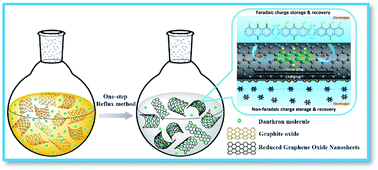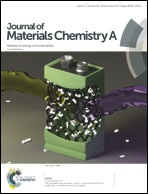Organic multi-electron redox couple-induced functionalization for enabling ultrahigh rate and cycling performances of supercapacitors†
Abstract
In the present work, the danthron molecule (1,8-dihydroxyanthraquinone, DT) with multi-electron redox centers as a novel organic electrochemically active material for supercapacitors has been decorated on reduced graphene oxide nanosheets (RGNs) via a facile one-step reflux method. The resultant danthron functionalized RGNs (DT–RGNs) composite electrode material not only provided a fast and reversible 4e−/4H+ redox reaction because of two types of redox-active organic functional groups (carbonyl and hydroxyl) in DT, but also preserved the unique electrode architecture with the required conductivity of the graphene nanosheets. In the three-electrode system, the optimized electrode (DT–RGNs 3 : 5) exhibited an excellent capacitance of 491 F g−1 at 1 A g−1 which is three times higher than that of bare RGNs. Most importantly, the DT–RGNs electrode showed an ultrahigh rate capability of 80.8% capacitance retention at 100 A g−1 and a superior electrochemical stability of 98.8% after 10 000 cycles at 10 A g−1, outstripping a great amount of reported organic and inorganic electrodes. Meanwhile, the effect of intramolecular and/or intermolecular hydrogen bonds between carbonyl and hydroxyl on the electrochemical properties of the DT–RGNs electrode was investigated. Finally, the novel symmetric supercapacitor (DT–RGNs SSC) was assembled to evaluate the actual energy storage properties of electrode materials.



 Please wait while we load your content...
Please wait while we load your content...